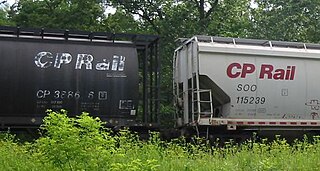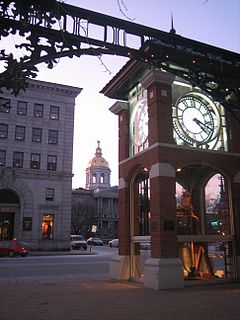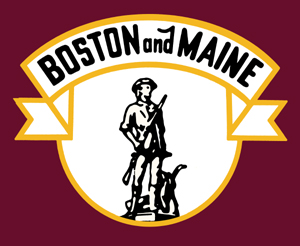
The Boston and Maine Corporation, known as the Boston and Maine Railroad (B&M), was a U.S. Class I railroad in northern New England. It became part of what is now the Pan Am Railways network in 1983.
The Central Vermont Railway was a railroad that operated in the U.S. states of Connecticut, Massachusetts, New Hampshire, New York, and Vermont, as well as the Canadian province of Quebec.

The St. Lawrence and Atlantic Railroad, known as St-Laurent et Atlantique Quebec in Canada, is a short-line railway operating between Portland, Maine, on the Atlantic Ocean, and Montreal, Quebec, on the St. Lawrence River. It crosses the Canada–US border at Norton, Vermont and Stanhope, Quebec, and is owned by short-line operator Genesee & Wyoming.
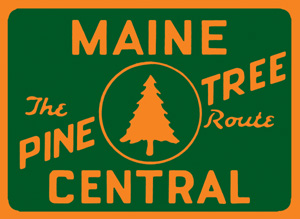
The Maine Central Railroad Company was a former U. S. Class I railroad in central and southern Maine. It was chartered in 1856 and began operations in 1862. By 1884, Maine Central was the longest railroad in New England. Maine Central had expanded to 1,358 miles (2,185 km) when the United States Railroad Administration assumed control in 1917. The main line extended from South Portland, Maine, east to the Canada–United States border with New Brunswick, and a Mountain Division extended west from Portland to Vermont and north into Quebec. The main line was double track from South Portland to Royal Junction, where it split into a "lower road" through Brunswick and Augusta and a "back road" through Lewiston which converged at Waterville into single track to Bangor and points east. Branch lines served the industrial center of Rumford, a resort hotel on Moosehead Lake, and coastal communities from Bath to Eastport.

Pan Am Railways, Inc. (PAR), known before March 2006 as Guilford Rail System, is an American holding company that owns and operates Class II regional railroads covering northern New England from Mattawamkeag, Maine, to Rotterdam Junction, New York. The primary subsidiaries of Pan Am Railways are Boston and Maine Corporation, Maine Central Railroad Company, Portland Terminal Company, and Springfield Terminal Railway Company.

The Fitchburg Railroad is a former railroad company, which built a railroad line across northern Massachusetts, United States, leading to and through the Hoosac Tunnel. The Fitchburg was leased to the Boston and Maine Railroad in 1900. The main line from Boston to Fitchburg is now operated as the MBTA Fitchburg Line; Pan Am Railways runs freight service on some other portions.
The European and North American Railway (E&NA) is the name for three historic Canadian and American railways which were built in New Brunswick and Maine.

The Green Mountain Railroad is a class III railroad operating in Vermont.

Halls Stream or Rivière Hall is a 25.2-mile-long (40.6 km) tributary of the Connecticut River in eastern North America. For most of its length, it forms the Canada–United States border, with the province of Quebec (Canada) to its west and the state of New Hampshire to its east.

Vermont Route 114 (VT 114) is a 51.24-mile (82.46 km) state highway in northeastern Vermont in the United States. It runs northward from U.S. Route 5 (US 5) in Lyndon until nearing the Canada–United States border in the town of Norton; thereafter, the road continues east to the New Hampshire state line in Canaan. The vast majority of VT 114 is situated within Essex County; however, the route also passes through small, isolated portions of Caledonia and Orleans Counties.
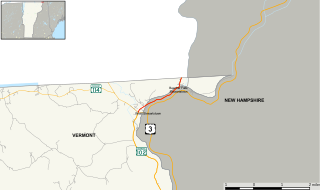
Vermont Route 253 (VT 253) is a 2.159-mile (3.475 km) long state highway located entirely within the town of Canaan in Essex County, Vermont, in the United States. It extends from a junction with VT 102 and VT 114 to the Canadian border, where it continues into Quebec as Route 253. VT 253 is known in Canaan as Christian Hill Road.

The Mountain Division is a railroad line that was once owned and operated by the Maine Central Railroad (MEC). It stretches from Portland, Maine on the Atlantic Ocean, through the Western Maine Mountains and White Mountains of New Hampshire, ending at St. Johnsbury, Vermont in the Northeast Kingdom. The line was abandoned in 1983 by MEC's successor, Guilford Transportation Industries (GTI). Guilford retained a stub between Portland and Westbrook. A section in New Hampshire remains in use by heritage railway Conway Scenic Railroad.
The Calais Branch is a mothballed railroad line in Maine that was operated by the Maine Central Railroad Company (MEC).

West Stewartstown is a census-designated place in the town of Stewartstown in Coos County, New Hampshire, United States. It had a population of 386 at the 2010 census.

The Northern Recreational Rail Trail, also known as the Northern Rail Trail, is a 58-mile (93 km) multi-use rail trail in western New Hampshire, USA, running from Lebanon to Boscawen. It uses the right-of-way of the Boston and Maine Railroad's former Northern Line, which was acquired by the State of New Hampshire in 1996. The trail is managed by the New Hampshire Bureau of Trails.
Woodland Rail, LLC is a non-carrier railroad company that owns an 11.83 mi (19.04 km) rail line located in the state of Maine and province of New Brunswick. It was formed in 2012 as a subsidiary company of Woodland Pulp, LLC, which owns and operates a pulp mill in the Woodland neighborhood of the town of Baileyville, Maine.
The Massawippi Valley Railway was a short line railway established 1870 between Lennoxville, Quebec, and the Vermont border. Part of the Quebec Central Railway from 1926, the line was abandoned in 1990 and removed in 1992. Most of the former railway's path is now bicycle trails.

The Canaan–Hereford Road Border Crossing connects the towns of Saint-Herménégilde, Quebec and Canaan, Vermont on the Canada–US border. The crossing is at the junction of Quebec Route 141 and Vermont Route 141, and is open 24 hours for non-commercial traffic. Both the US and Canada border inspection stations are among the oldest buildings still being operated by the respective agencies. The US border station was listed on the National Register of Historic Places in 2014.

The Portsmouth, Great Falls and Conway Railroad (PGF&C) is a former rail line between Rollinsford and Intervale, New Hampshire, in the United States. At Rollinsford, the line connected to other lines to provide service between the White Mountains and coastal cities such as Boston. At Intervale, it connected to the Mountain Division of the Maine Central Railroad. The rail line takes its name from the city of Portsmouth, near its southern terminus; the city of Somersworth ; and the town of Conway, near its northern terminus. Today, the infrastructure of the former PGF&C is owned by different entities, including the State of New Hampshire, the Conway Scenic Railroad, and the New Hampshire Northcoast Corporation. Some segments are still operated as freight or heritage railways, while other segments are being maintained as rail trails.

